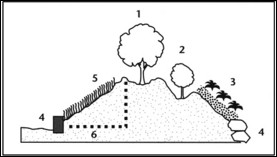 Planting Problems of a Berm 1. Soil on top is dry, so depress center to keep water from running off. 2. Make water holding depressions for planting. 3. Mulch with an erosion-resistant material such as wood chips and plant ground covers. 4. Hold difficult slopes with stone retaining walls or treated wood ties. 5. Grass is difficult to mow on a slope so use only uncut field grass. 6 Use a maximum 2-3 slope. |
Man-made hills, as well as natural ones, can modify sunlight and wind. This principle gives us one of the easiest and most useful tools in influencing our microclimate. It is relatively inexpensive to create a mound of earth (technically known as a berm) to block or channel wind or sun, and much faster than waiting for trees to grow tall.
A berm that’s well designed and planted on top with trees and shrubs can become one of the important attractions of distinctive landscaping. A carefully located berm can provide privacy and noise control, too, reducing noise levels by as much as 80 percent.
Graceful, artistic berms are not used often enough. Most builders seem unaware of their existence. Berms form the basic artistry of Japanese gardens. Large, half-buried rocks and stone walls lend themselves beautifully in such designs. Fortunate are the few who can excavate for a new house or addition and have extra earth to work with. To truly sculpt the land, one should leave it with a graceful, undulating surface rather than flat and empty like an engineer’s drawing board at five o’clock.
Earth berms can be beautiful when planted with shrubbery and ground covers. They can be landscaped with interesting plants or used to grow vegetables and flowers. Berms present special growing problems, however. Because water runs off the sides, they are usually drier than the surrounding ground. If the sides are too steep, they will erode or wash away. Stone retaining walls and large rocks are useful remedies. Or railroad ties may be used to hold the soil. The roots of plant material also hold the the soil, eventually. Rough wood chips make an excellent, inexpensive, erosion-retardant mulch. The less steep the slope, the less problem with erosion.
When putting plants on berms, care must be taken for adequate water. The tops of berms are very dry. Water-holding plant pockets must be fashioned when you do any planting. The pockets can be depressions or terracing on the sloping sides or a shallow trench on top. Plant material that needs relatively little water does best. It is difficult to mow grass on the sides of berms, so grass should be used only if it is to be kept as an uncut meadow.
Credit: www.mothersgarden.net




























